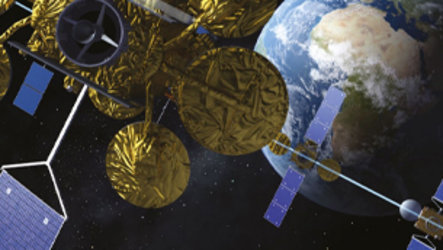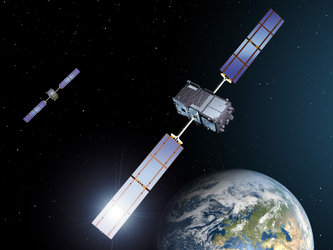Third Galileo satellite begins transmitting navigation signal
Europe’s third Galileo satellite has transmitted its first test navigation signals back to Earth. The two Galileo satellites launched last October have reached their final orbital position and are in the midst of testing.
The third Galileo Flight Model, known as FM3, transmitted its first test navigation signal in the E1 band on 1 December, the band being used for Galileo’s freely available Open Service interoperable with GPS.
Then, on the morning of 4 December, the satellite broadcast signals across all three Galileo bands – E1, E5 and E6.
Galileo is designed to provide highly accurate timing and navigation services to users around the world. So the testing is being carried out in addition to the standard satellite commissioning to confirm that the critical navigation payloads have not been degraded by the violence of launch.

While the satellites are run from Galileo’s Oberpfaffenhofen Control Centre near Munich in Germany and their navigation payloads are overseen from Galileo’s Mission Control Centre in Fucino, Italy, a separate site is used for the in-orbit testing.
Located in the heart of Belgium’s Ardennes forest, Redu is specially equipped for Galileo testing, with a 15 m-diameter S-band antenna to upload commands and receive telemetry from the satellite, and a 20 m-diameter L-band dish to monitor the shape and quality of navigation signals at high resolution.
“This marked the very first time that a Galileo payload was activated directly from ESA’s Redu centre in Belgium,” explained Marco Falcone, overseeing the campaign effort as Galileo’s System Manager.

“We have now established an end-to-end setup in Redu that allows us to upload commands generated from Fucino’s Galileo Control Centre to the satellite payload whenever the satellite passes over the station, while at the same time directly receiving the resulting navigation signal through its main L-band antenna.
“The result is our operations are much more effective, shortening the time needed for payload in orbit testing.”
Operating at an altitude of 23 222 km, the Galileo satellites take about 14 hours to orbit our planet, typically coming into view of Redu for between three to nine hours each day.
The fourth Galileo flight model, FM4, was launched together with FM3 on 12 October. The two satellites shared the same Soyuz launcher from French Guiana.
Both have now been manoeuvred into their operational orbits: at the same altitude but in a different orbital plane to the first two Galileos, launched in 2011, in order to maximise the global coverage.
Now that FM3’s payload has been activated, FM4 is set to begin transmitting test navigation signals later this month. The first two satellites have already passed their in-orbit testing.















 Germany
Germany
 Austria
Austria
 Belgium
Belgium
 Denmark
Denmark
 Spain
Spain
 Estonia
Estonia
 Finland
Finland
 France
France
 Greece
Greece
 Hungary
Hungary
 Ireland
Ireland
 Italy
Italy
 Luxembourg
Luxembourg
 Norway
Norway
 The Netherlands
The Netherlands
 Poland
Poland
 Portugal
Portugal
 Czechia
Czechia
 Romania
Romania
 United Kingdom
United Kingdom
 Slovenia
Slovenia
 Sweden
Sweden
 Switzerland
Switzerland


































